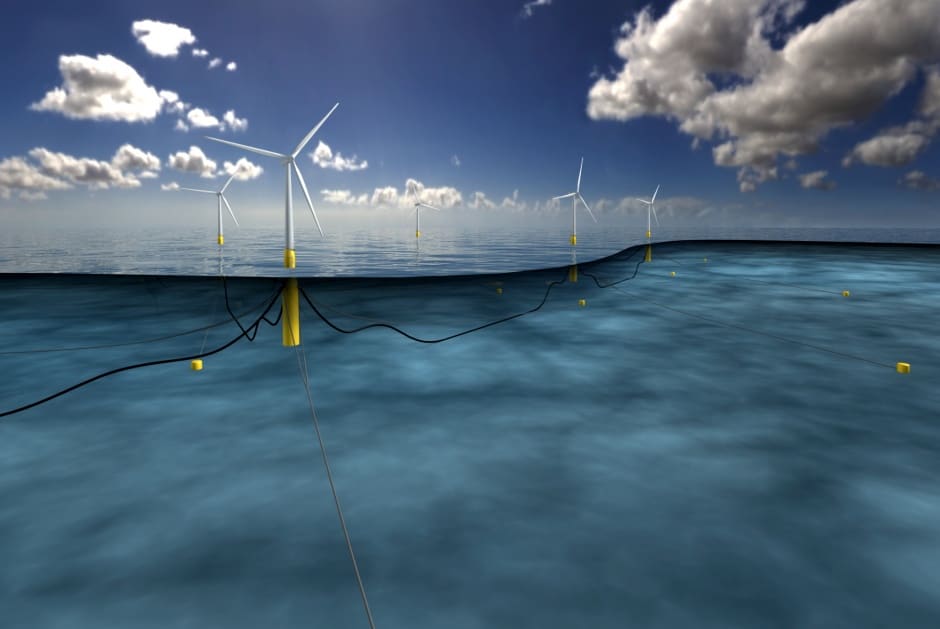
From the surface, the spinning blades of the wind turbine sitting off the coast of Norway look much like those of any other offshore device.
But it is underneath the waves where the difference becomes clear.
That is because unlike conventional offshore wind turbines, the Hywind device is not fixed to the seabed by foundations, but is instead attached to a cylindrical structure that floats in the water. Tethers anchored to the ocean floor prevent it from drifting out to sea.
Now the company behind the floating turbine, Statoil, is planning to build five 6MW devices off the coast of Scotland.
Floating devices can tap into the vast energy resources available further offshore, where wind speeds tend to be higher and steadier
The 30MW pilot wind farm, which is due to be completed in 2017 near Buchan Deep, around 25km off the coast of Peterhead in Aberdeenshire, will be the first array of its kind. It is expected to generate around 135GWh of energy per year, or enough electricity to power 20,000 homes.
Unlike fixed offshore wind turbines, floating devices can be placed in deeper waters of up to 150m. This allows them to tap into the vast energy resources available further offshore, where wind speeds tend to be higher and steadier. Turbulence is also lower further offshore, which should ensure the turbines have a longer operating life.
In Europe, over half of the North Sea is considered suitable for floating wind farms, with water depths of between 50m and 220m. The European Wind Energy Association estimates that energy from turbines at depths of over 50m in the North Sea could meet the EU’s electricity needs four times over. As a result, the technology is generating increasing interest around the world, with projects already under construction or in the pipeline around the coast of Europe, Japan and the US.
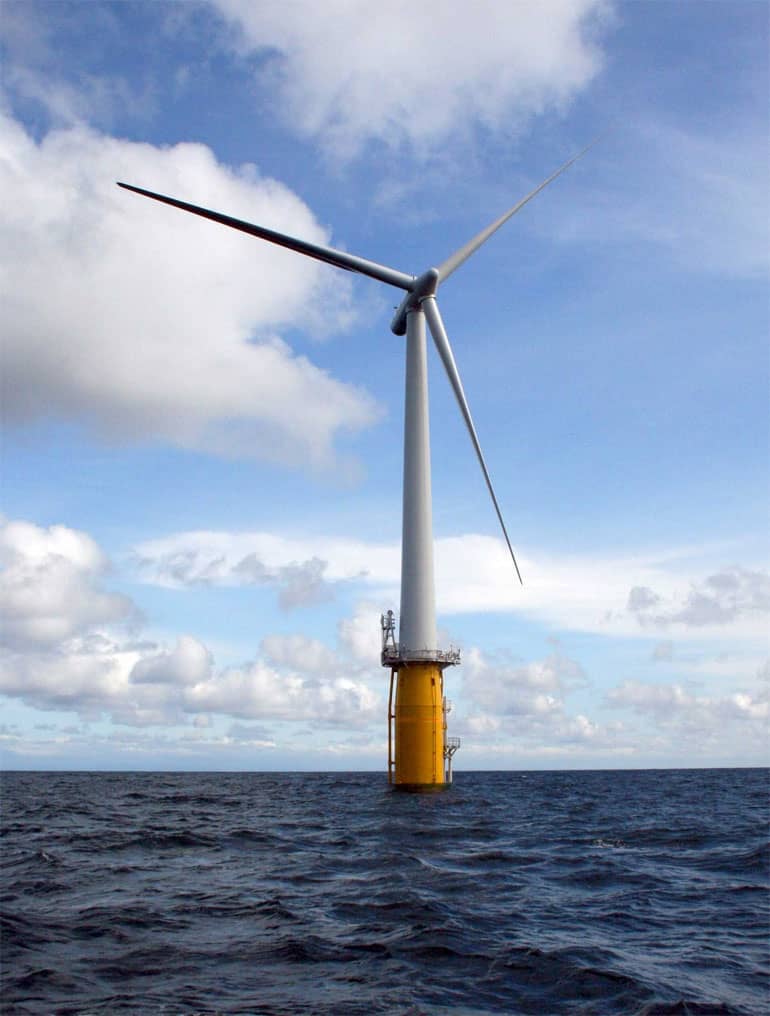
In the UK, these projects are around the coast of Scotland, including the Buchan Deep site and a further two pilot farms planned near Kincardine and Dounreay.
The UK is already an acknowledged world leader in offshore wind power, with over 5GW of installed capacity. The Energy Technologies Institute, a public-private partnership between the UK government and energy companies, estimates that this could increase to between 20–55GW by 2050.
But at these levels, the number of attractive sites for fixed-bed wind turbines, less than 30km from the shore and where water depths are no greater than 40m, are likely to be few and far between. Building fixed offshore turbines in sites that are further from the shore, or in deeper waters, adds considerably to the cost and complexity of any project.
Conditions on the ocean floor can also add to the difficulties, and cost, of building fixed offshore turbines, according to Rhodri James, manager for policy and innovation at the Carbon Trust, which published a detailed report on floating wind in 2015.
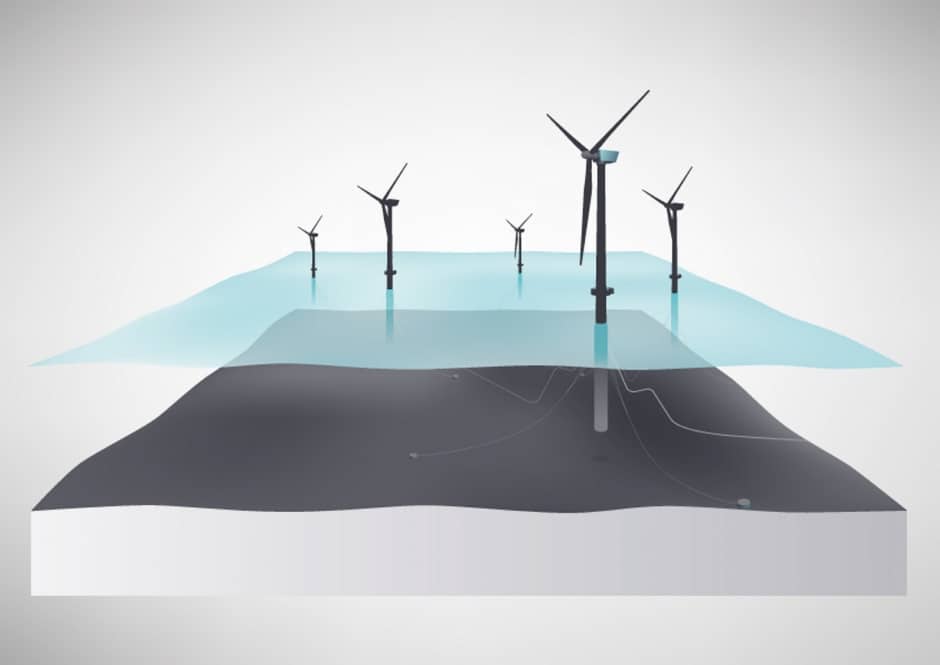
“A number of fixed projects have found themselves facing quite complex seabeds, particularly where the soil is harder, so there are opportunities to locate floating wind where you wouldn’t be able to locate a fixed wind farm,” said James.
What’s more, installing floating wind turbines offshore is cheaper and simpler than fixed devices. That is because expensive heavy-lift vessels are needed to assemble and install fixed turbines on the seabed.
In contrast, most floating wind devices can be fully assembled at port-side, and then simply towed to their offshore location using lower-cost and readily available tug vessels, said James.
This is likely to make a considerable difference as the industry moves from 4–6MW turbines to 8–10MW and above, he said. “The ability to assemble the devices at port-side and tow them to site should work in the favour of floating wind over the next 10–15 years or so, as turbine sizes increase.”
Hywind structures can be used with any type of wind turbine
As a result, floating offshore wind farms should start to become increasingly attractive, said James.
This is particularly the case in Scotland, where there are high offshore wind speeds and a large number of sites at which waters become deep relatively close to the shore.
At Buchan Deep, Statoil plans to locate its Hywind devices in water depths of around 95–120m. Each device will consist of a turbine placed on top of a ballasted steel cylinder, known as a spar-buoy.
The structures will be anchored to the seabed using three mooring lines, while a pitch motion controller will prevent them moving around too much in the wind and waves.
According to Statoil, the Hywind structures can be used with any type of wind turbine, providing the combined weight of the nacelle and rotor do not fall outside the levels required to maintain stability.
A pilot Hywind device, installed off the coast of Norway and equipped with a 2.3MW Siemens turbine, has operated successfully since 2009, making it the world’s first full-scale floating wind turbine, according to Elin Isaksen, spokesperson for Statoil. In that time, it has generated around 32.5 GWh of electricity.
“The experience from the Hywind Demo has been used to further optimise the floater motion controller, so that the movement can be even better controlled,” she said. “This will become increasingly important as the turbine size increases.”
The company hopes the plant will open up new possibilities for floating wind around the globe, including the US and Japan. “We believe industrialisation of floating wind is a key opportunity for companies such as ours with skill-sets from the oil and gas business,” she said.
The Hywind plant will also pilot the use of batteries to store excess energy produced by the floating turbines for use at periods of high demand. A 1MWh lithium battery-based storage system, known as Batwind, will be installed at the site in late 2018, under an agreement between Statoil, the Scottish government, the Offshore Renewable Energy Catapult and Scottish Enterprise.
But while the Hywind plant will mark the first time multiple turbines have been installed together as an array, it is by no means the only project designed to take advantage of the winds in deeper waters.
In Japan, a project known as Fukushima Forward has been installing floating turbines at its site 20km off the coast of north-east mainland Japan since 2013.
The Fukushima nuclear disaster in 2011 stimulated Japanese interest in alternative, renewable technologies, and in particular focused efforts into offshore wind power. Unlike the UK though, Japan is surrounded by deep water, making it unsuitable for fixed-bed offshore wind, but a prime candidate for floating turbines.
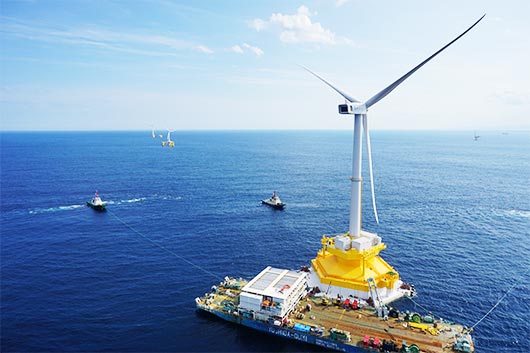
In 2013, the Fukushima Forward project installed one 2MW Hitachi turbine and a floating substation at the site, which was followed in 2015 by a 7MW device, built by Mitsubishi Heavy Industries. In July this year the team installed a final 5MW Hitachi turbine, dubbed the Fukushima Hamakaze, making it the largest floating wind farm in the world, at 14MW.
Unlike the Hywind devices, the 2MW and 7MW Fukushima turbines are both installed on semi-submersibles, or buoyancy-stabilised platforms that float, semi-submerged, on the surface of the water. Mooring lines anchor the platforms to the seabed.
The four-column semi-submersible platform used to support the 2MW Fukushima Mirai turbine, which was built by Mitsui, has already survived an earthquake, measuring 7.1 on the Richter scale, and minor tsunami, as well as two typhoons.
The 7MW Fukushima Shimpuu turbine, meanwhile, is installed on a v-shaped semi-submersible, with three columns, including one supporting the turbine.
In contrast, the floating substation and Hamakaze turbine are installed on an advanced spar design, built by Japan Marine United. This consists of a shorter cylinder than conventional spar-buoy structures like Hywind, for use in shallower waters. Fins fitted around the bottom of the spar help minimise sway in the water.
But despite the apparent success of Fukushima Forward so far, the project has been expensive, according to James. And while Japan has built up a great deal of knowledge about floating wind in the process of this work, the country lacks the advantage of the offshore know-how and infrastructure built up in Europe through the fixed wind and oil and gas industries, he said.
“However, it will be interesting to see what they do beyond this stage of the project,” said James. “There has been talk of building the same site out, originally to 1GW, although it may well be closer to 100MW, in time for the Tokyo Games in 2020.”
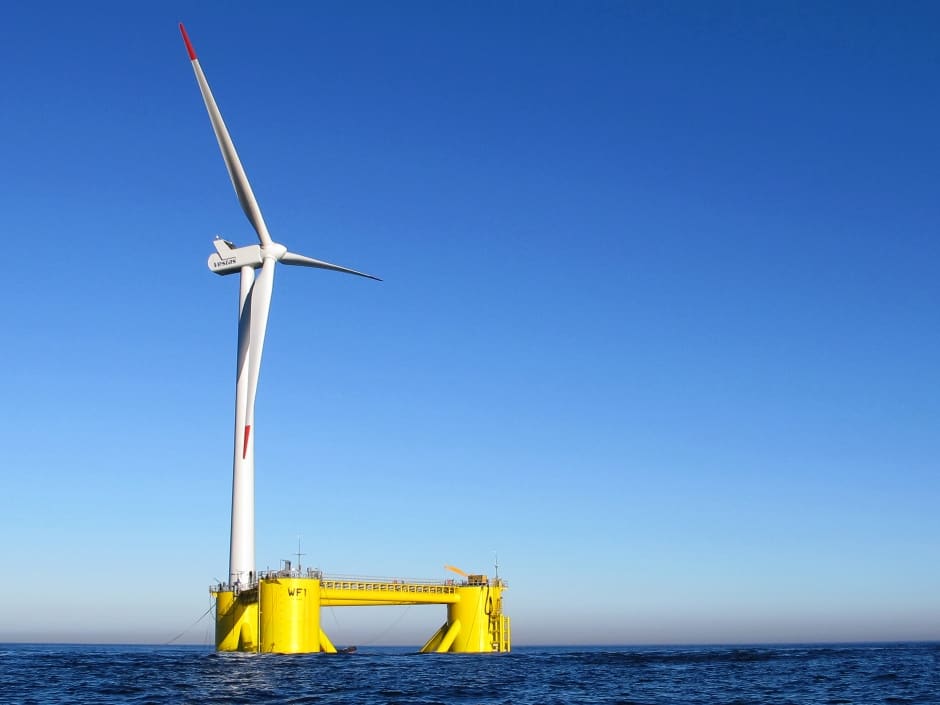
Meanwhile, a 2MW prototype floating turbine, known as WindFloat, is also generating energy off the coast of Aguçadoura in Portugal. The device, which was developed by US-based Principle Power, has already provided more than 16GWh of electricity to the local grid, since its installation in 2011.
The company is now planning to build a three 8.3MW turbine array at the site. Like the prototype, the WindFloat turbines will sit on a semi-submersible hub consisting of three columns.
Principle Power also has plans for a further plant off the coast of Scotland, as well as arrays in Hawaii and Oregon in the US.
This summer, French offshore wind power firm Eolfi won a bid to build a floating wind farm consisting of four 6MW General Electric turbines off Groix Island, on the coast of Brittany. The turbines will sit atop four-columned semi-submersible floaters built by French naval manufacturer DCNS, in collaboration with construction company Vinci.
The wind farm, which will be anchored around 14km from the coast and connected to the shore by underwater cables, has a 20-year power purchase agreement in place.
Each 8m-wide star-shaped floater is built from concrete and steel, and ballasted with 7,000 tonnes of seawater, according to Marc Lanne, maritime senior project manager at Eolfi.
“We hope to have the devices installed at sea in 2020, which is quite an aggressive target,” he said.
France has woken up relatively late to the opportunities, said Lanne. As such, the country missed the boat in benefitting from first-mover advantage in fixed-bed offshore wind, but now recognises the opportunities offered by floating wind, he said.
“With floating wind, it’s more flexible, it’s further from the coast, which means it is less obtrusive, and manufacturing is easier because everything can be constructed in the harbour,” said Lanne.
Once the pilot wind farm is in operation, Eolfi hopes to be able to move quickly to build a commercial plant in a few years. And although the company is currently reliant on French government grants, it hopes to be able to compete with market prices for offshore wind in 10–15 years.
If the technology is given the support it needs, the Hywind plant could be the first of many wind farms floating off our shores.
Likewise, Statoil estimates that it can ultimately reach a levelised cost of electricity (LCOE) from its floating wind farms of £85–95/MWh.
So far, the data from technology developers suggests that this figure should be achievable, and should ultimately allow it to compete on cost with fixed wind, according to the Carbon Trust’s James.
“Floating wind is going to be more expensive than fixed wind for at least the next five years, and probably the next 10 years, but the costs can certainly come down,” he said. “Certainly by 2030, there are studies to show it should start to reach parity with fixed wind.”
But floating wind will only succeed if it is given the right support, he argues. In the past the technology has suffered somewhat by being placed in the same category as fixed offshore wind. Instead, it needs to be treated as a separate technology in its own right, with its own support mechanisms put in place.
But if the technology is given the support it needs, the Hywind plant could be the first of many wind farms floating off our shores.




Red Bull makes hydrogen fuel cell play with AVL
Formula 1 is an anachronistic anomaly where its only cutting edge is in engine development. The rules prohibit any real innovation and there would be...